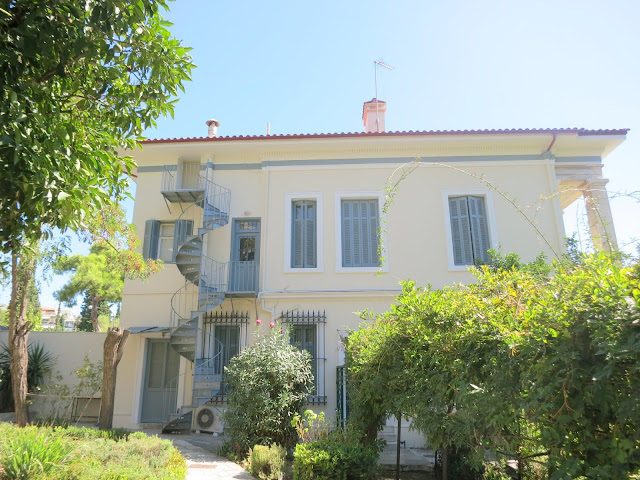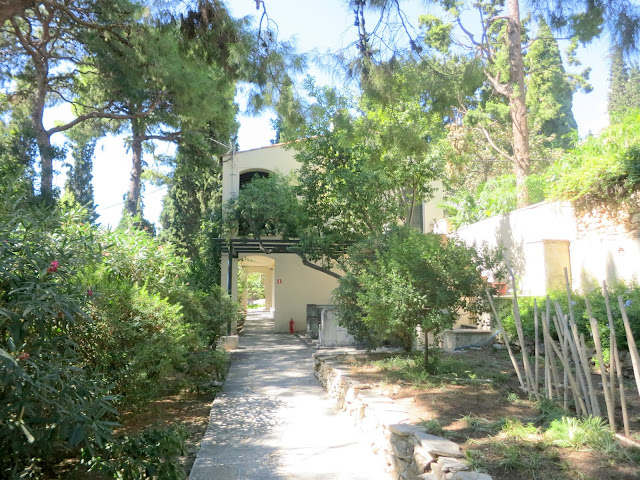Prosaic Origins by Andreas Lolis,
at the British School of Athens.
This exhibition is part of NEON's City Project, an initiative for public art and the city, which aims to activate public and historical places through contemporary art, contributing to the interaction of art, society and the city. This year it's staged at the British School of Athens which was founded in 1886 to promote the study of Greece in all its aspects. It's best known for archaeological investigation and the establishment of science-based archaeology. The site comprises administrative buildings, a hostel that provides accommodation for researchers, a library, an archive and laboratory. The garden is an oasis in the middle of a busy, bustling city, and the site-specific sculptures are placed within it, blending in with the space, installed in such a way as if they had always been there. Consequently, this post incorporates both the garden and the objects placed within it.
Using marble, the main material of the Classical era, Lolis has created mostly abandoned objects, makeshift constructions and ordinary things, elevating them to the status of statues. They collide with the western idealisation of Classical Greek art. These objects, carved rubbish bags, goods palettes, discarded polysterene, which would normally go mostly unnoticed, mark the material and logistical world of consumption, waste and trade; within this framework these objects are frequently reused, re-entering a new cycle: a cardboard box used as material for a shelter; a palett left out the back of a warehouse has the potential to become a seat, a makeshift ladder, etc. These objects are part of the 'landscape of crisis' of contemporary Greece. They reveal the not-so-hidden quality of the city in crisis, reminding us of the many unfortunate souls that are forced to sleep in makeshift homes.
The title of the exhibition, Prosaic Origins, could be said to strip archaeological findings of the weighty significance we might attach to them. They are joining a great proportion of the countless ancient marble objects found throughout the city. They too, will one day become artefacts themselves, they too will be remembered and forgotten, will be lost and found.
Lois faithfully copies the original object, creating a kind of sculptural trompe-l'oeil: these pieces are both a copy of nature and a monument to human craft. It is not idealised nature as the archetype of beauty that is cast into the marble sculptures, but human made objects with a short economic life.
Placed on the grounds of the British School without any marker of their status as sculptures, no base or plinth, they question the notion of artistic value. Lolis is displacing the heavy historical weight of marble sculpture, making it a means of petrification of the precarious and transitory dimension of modern life.
I would not have given these two 'plastic' rubbish bags another glance, had I not read about the exhibition before visiting.
This marble sculpture visually 'pollutes' the site at the entrance of the British School. The ugly barometers of our daily consumption, undesirable objects that we classify as refuse, they are something that we would rather hide than keep revealed. And yet, in the current state of crisis, for some, rubbish bags become a potential source of food or income - a sight that is normal in today's Athens.
Once we enter through the gate into the garden, another sculptural installation (marble), consisting of rubbish bags, wooden pallets, and a piece of polysterene. Another unappealing, yet familiar sight of abandoned objects that have lost their function, monuments of transition and obsolescence.
A closer look at the piece of polysterene, which is so realistic.
We walked past the main building of the School
through this narrow passage of bushes and trees
and reached the side of the main building
typical example of Neo-Classical Greek architecture
in the middle of the clearing, an exact replica of an original park bench (wood, iron), creating a seemingly idyllic scene.
A makeshift bed and pillow (marble) rests on the bench, a marker of homelessness, an all-too familiar sight in the parks of Athens. Placed at a beautiful and central spot in the garden, it disrupts the bucolic scenery, a comment on Greece's current social economic and political situation.
Hard to imagine that this pillow is made of marble.
This clearing, this 'square' is flanked by another building
and a shady harbour where a family were sitting
paths lead to the back of the main building
a pergola
more seating areas
Thrown carelessly by some bushes we spotted a ladder. Having understood how this exhibition works, we went near to investigate, and sure enough, it's a marble sculpture
We were asked not to explore the parts of the garden on our left, pictured here, as they are part of the boundaries with the American School of Classical Studies. I was tempted, as I worked there in the library for two years before making my way to the UK and University. But, we resisted
At the end of this paved narrow path we could see the White Room
We reached the White Room which has been placed in front of yet another of the School's buildings
A roofless white chamber fluctuating between two states: shelter and confinement. At the same time airy, light and claustrophobic, its interior resembles a mausoleum.
detail
detail
We almost missed this one (even though there is an exhibition catalogue detailing the sculptures, we were told that some are not listed as visitors are encouraged to search for some sculptures that have been missed out. 'We are trying to be playful', we were told).
A piece of broken polystyrene (marble) on the steps
We turned round, taking a different path which eventually would lead us, full circle, to where we had started from. On our path, near an air-conditioner, another cardboard box (marble)
On the side of the steps, another assemblage of four small sculptures brought together into a single composition:
two goods pallets, a piece of polysterene, and a piece of cardboard
the detail is exquisite
up the steps we went
then along this path
past the front of the building we had seen earlier in the clearing
found another black plastic bag of rubbish (marble)
a piece of discarded wood (marble)
past this lovely seating area
and came upon a row of canes (marble)
We had come full circle.
Not wanting to leave yet, we sat here for a while, the sitting area where we had observed the family earlier on. Peaceful and relaxing.
A wonderful exhibition, like an adventure, a treasure-hunt, one that we will remember for a while.























































No comments:
Post a Comment